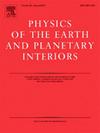A method for simultaneously determining Earth's magnetic field and mantle conductivity models using MSS-1 and Swarm satellite magnetic data
IF 1.9
3区 地球科学
Q2 GEOCHEMISTRY & GEOPHYSICS
引用次数: 0
Abstract
The magnetospheric primary and its Earth mantle-induced fields are essential components of geomagnetic field models. Previous geomagnetic field modeling methods typically use a fixed a priori Earth's mantle conductivity model to account for the induced field. This treatment may reduce accuracy, as electromagnetic induction depends on conductivity models. Here, we propose a new method that simultaneously determines the mantle conductivity model during geomagnetic field modeling. This method has the advantages of (i) self-consistently accounting for the induced field in geomagnetic field modeling, and (ii) simultaneously providing valuable information on Earth's internal structure. We implement the method into a new computationally parallel field modeling framework, which scales nearly linearly up to a large number of MPI cores. The Macau Science Satellite-1 (MSS-1), primarily aiming to accurately measure the Earth's magnetic field, was successfully launched on May 21, 2023. We apply our method to the magnetic data from MSS-1 as well as Swarm satellites and obtain the first self-consistent models of Earth's magnetic field and mantle conductivity. We also investigate how different conductivity models affect geomagnetic field modeling. Our results show that a fixed a priori conductivity model introduces field differences of about 2–4 nT in magnetic field models. These field differences, which are larger than the measuring accuracy of modern geomagnetic satellites, can be avoided by our method.

利用MSS-1和Swarm卫星磁数据同时确定地球磁场和地幔电导率模型的方法
磁层原生场及其地幔感应场是地磁场模型的重要组成部分。以前的地磁场建模方法通常使用一个固定的先验地球地幔电导率模型来解释感应场。这种处理可能会降低精度,因为电磁感应取决于电导率模型。本文提出了一种在地磁场模拟过程中同时确定地幔电导率模型的新方法。该方法具有以下优点:(1)自洽地磁场建模中感应场的计算;(2)同时提供有价值的地球内部结构信息。我们将该方法实现到一个新的计算并行场建模框架中,该框架几乎线性地扩展到大量的MPI内核。澳门科学卫星一号(MSS-1)于2023年5月21日成功发射,主要目的是精确测量地球磁场。我们将该方法应用于MSS-1和Swarm卫星的磁场数据,获得了第一个自一致的地球磁场和地幔电导率模型。我们还研究了不同的电导率模型如何影响地磁场建模。我们的研究结果表明,一个固定的先验电导率模型在磁场模型中引入了大约2-4 nT的场差。这些场差大于现代地磁卫星的测量精度,用我们的方法可以避免。
本文章由计算机程序翻译,如有差异,请以英文原文为准。
求助全文
约1分钟内获得全文
求助全文
来源期刊

Physics of the Earth and Planetary Interiors
地学天文-地球化学与地球物理
CiteScore
5.00
自引率
4.30%
发文量
78
审稿时长
18.5 weeks
期刊介绍:
Launched in 1968 to fill the need for an international journal in the field of planetary physics, geodesy and geophysics, Physics of the Earth and Planetary Interiors has now grown to become important reading matter for all geophysicists. It is the only journal to be entirely devoted to the physical and chemical processes of planetary interiors.
Original research papers, review articles, short communications and book reviews are all published on a regular basis; and from time to time special issues of the journal are devoted to the publication of the proceedings of symposia and congresses which the editors feel will be of particular interest to the reader.
 求助内容:
求助内容: 应助结果提醒方式:
应助结果提醒方式:


